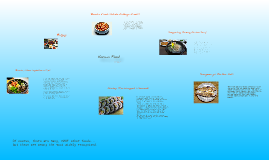Korean Food
Transcript: While in Korea you will try MANY dishes...here are some of them... Bulgogi Pulgogi is one of Korea's most famous grilled dishes. It is made from sirloin or another prime cut of beef, cut into thin strips. For an outside barbecue, the meat is marinated for at least four hours to enhance the flavor and to tenderize it in a mixture of sesame oil, soy sauce, black pepper, garlic, sugar, onions, ginger, and wine. The marinated beef is cooked on a metal dish over the burner. Whole cloves of garlic, sliced onions, and chopped green peppers are often grilled at the same time. Baechu Kimchi (Whole Cabbage Kimchi) This is the most common, classic kimchi you will find at a Korean meal. It is made from cabbage and spices - including the spicy hot red pepper paste! Historically it was fermented in Kimchi jars stored outside in climate-monitored areas, but today Kimchi can be made with special Kimchi refrigerators! There are over 100 varieties including white Kimchi. Each family typically has their own recipe. Samgye-tang (Ginseng Chicken Soup) The body cavity of a small chicken is stuffed with glutinous rice, young ginseng shoots, and jujubes. The chicken is then boiled in a clear stock and served in an individual earthenware pot. It is highly recommended for those new to Korean food. This dish is famous as summer dish. Koreans try to survive the summer heat with hot stamina food. This wonderful dish is gradually being recognized by the rest of the world. Even if you are skeptical about the properties attributed to ginseng, you will enjoy this dish which is said to give stamina during the steamy Korean summers. Bibimbap (Mixed Vegetables on Rice) A simple but popular dish, bibimbap is a bowl of hot rice served in a bowl topped with a variety of vegetables (cooked and raw) arranged on top. Vegetables can be seasonal, with toraji, bell flower roots, gosari, bracken, bean sprouts, and spinach often served. Other ingredients can include chestnuts, jujubes, ginseng, and a small amount of seafood or meat. An egg may be also served on the top. Most restaurants prepare the dish with a big scoop of gochujang and red pepper paste placed with the vegetables. Most areas of Korea have their own unique way of making Bipambap. It will be unique no matter where you go! Saengseon-gui (Grilled Fish) The Korean way of grilling seafood is to use the entire fish (including the head!) with simple seasonings such as salt, soy sauce, or hot pepper sauce. Popular choices of fish for this style of cooking include snapper, herring, mackerel, sole, and flounder. Grilled squid (ojingeo-gui) is also very popular. Gimbap (Rice Wrapped in Seaweed) Korea's most popular and nutritious convenience meal. You can find it sold everywhere: picnics, schoolchildren's lunch boxes, street venders, and convenience stores. A layer of cooked rice is spread over a square piece of gim (dried laver). Various ingredients (including ham, sausage, spinach, cucumber, crab meat, carrots, and radishes) are thinly sliced and placed on top. The laver is rolled into a tube, sliced into sliced pieces, and seasoned with sesame seeds. The idea was borrowed from the Japanese during the colonial period, but Korean Gimbap is slightly different. Of course, there are many, MANY other foods... but these are among the most widely recognized. For more information go to www.lifeinkorea.com...this was my reference material! Korean Food

















